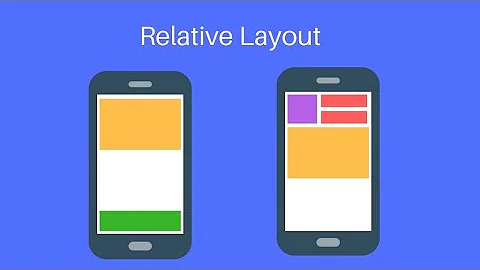How to get RelativeLayout working with merge and include?
Solution 1
There is an issue with the include tag. Check: https://issuetracker.google.com/issues/36908001
To fix it, make sure you overwrite BOTH layout_width and layout_height when including, otherwise everything will be ignored.
Solution 2
See the more highly voted answer below. Mine is woefully outdated
i can address one issue Justin raised: inability of RelativeLayout to manage positioning of an include (at least in this simple case, on a 1.6 emulator)
CommonsWare suggests wrapping the includes in a unique parent container, but does so in order to assist addressing & scoping identically named Views within Justin's includes
Each would have to have a unique parent container, and you would call findViewById() on that container (ViewGroup) rather than on the Activity.
In fact, you also must do it in order to get RelativeLayout to behave as expected:
This works (footer is well positioned):
<RelativeLayout xmlns:android="http://schemas.android.com/apk/res/android"
android:layout_width="fill_parent" android:layout_height="fill_parent">
<include android:id="@+id/header" layout="@layout/header"
android:layout_alignParentTop="true" />
<WebView android:id="@+id/webView" android:layout_below="@id/header"
android:background="#77CC0000" android:layout_height="wrap_content"
android:layout_width="fill_parent" android:focusable="false" />
<LinearLayout android:layout_alignParentBottom="true"
android:layout_height="wrap_content" android:layout_width="fill_parent">
<include android:id="@+id/footer" layout="@layout/footer" />
</LinearLayout>
</RelativeLayout>
This does not (footer is floating at top of screen):
<RelativeLayout xmlns:android="http://schemas.android.com/apk/res/android"
android:layout_width="fill_parent" android:layout_height="fill_parent">
<include android:id="@+id/header" layout="@layout/header"
android:layout_alignParentTop="true" />
<WebView android:id="@+id/webView" android:layout_below="@id/header"
android:background="#77CC0000" android:layout_height="wrap_content"
android:layout_width="fill_parent" android:focusable="false" />
<include android:id="@+id/footer" layout="@layout/footer"
android:layout_alignParentBottom="true" />
</RelativeLayout>
The bare footer include will not align to bottom of parent, without the surrounding LinearLayout.. I wouldn't call this expected behavior.
Additionally, the WebView appears to attach itself nicely to the header by ID, but I believe this to be illusion, due to it simply flowing below the header vertically. I also tried to set a button right above the footer include, but it got all floaty and wrong, too
RelativeLayout had more problems in 1.5, but i still like it :)
Solution 3
Man, this is old, but it seems to come up at the top of searches, so I'm going to comment.
I think the trick here is that the <merge> tag combined with the <include> tag essentially remove any sort of "parent" view group at that level. So then, who exactly are you asking to "layout_below" someone else? No one. There is no view at that level.
The <merge> tag takes the child views and pops them right into the parent of the <include> tag. You must therefore ask the children in the layout you're including to anchor themselves accordingly.
Solution 4
For positioning to work on RelativeLayout you need to set the layout_* parameters in the include file, not in the main layout file. That way
main_layout.xml
<RelativeLayout
android:id="@+id/header"
android:layout_width="fill_parent"
android:layout_height="wrap_content">
....
</RelativeLayout>
<RelativeLayout
android:id="@+id/footer"
android:layout_width="fill_parent"
android:layout_height="wrap_content"
android:layout_alignParentBottom="true">
.....
</RelativeLayout>
<include layout="@layout/content_layout" />
content_layout.xml
<merge xmlns:android="http://schemas.android.com/apk/res/android">
<RelativeLayout
android:id="@+id/content"
android:layout_width="fill_parent"
android:layout_height="fill_parent"
android:layout_above="@id/footer"
android:layout_below="@id/header" >
....
</RelativeLayout>
</merge>
This is obviously not what us developers want, but it's the only solution I've found to avoid duplicating xml
Solution 5
try :
<RelativeLayout xmlns:tools="http://schemas.android.com/tools"
xmlns:android="http://schemas.android.com/apk/res/android"
tools:showIn="@layout/activity_home">
Related videos on Youtube
Justin
Updated on July 08, 2022Comments
-
Justin almost 2 years
I have been trying for a few days now to make my layouts more efficient by converting from using several levels of nested
LinearLayoutsto oneRelativeLayoutand have come across a few problems that I haven not been able to find a workaround for...I have searched the Android beginners group and this site and have not been able to find anything that would help me solve the problem.
I read on one of the blogs that you can combine layouts with merge and include tags. So what I have is a main layout file with a
RelativeLayoutroot element. Inside of that I have 5 include tags that reference 5 different xml layout files that each have a merge element for the root (all of my merge files are the same except for the ids in them).I am running into two problems, which I will explain after posting a simplified version of my layout code:
Sample Main Layout File:
<?xml version="1.0" encoding="utf-8"?> <RelativeLayout xmlns:android="http://schemas.android.com/apk/res/android" android:layout_width="fill_parent" android:layout_height="fill_parent" android:background="@drawable/translucent_gray" > <include android:id="@+id/running_gallery_layout_id" layout="@layout/running_gallery_layout" /> <include android:id="@+id/recent_gallery_layout_id" layout="@layout/recent_gallery_layout" android:layout_below="@id/running_gallery_layout_id" /> <include android:id="@+id/service_gallery_layout_id" layout="@layout/service_gallery_layout" android:layout_below="@id/recent_gallery_layout_id" /> <include android:id="@+id/process_gallery_layout_id" layout="@layout/process_gallery_layout" android:layout_below="@id/service_gallery_layout_id" /> </RelativeLayout>Sample included merge file:
<?xml version="1.0" encoding="utf-8"?> <merge xmlns:android="http://schemas.android.com/apk/res/android"> <TextView style="@style/TitleText" android:id="@+id/service_gallery_title_text_id" android:layout_width="wrap_content" android:layout_height="wrap_content" android:gravity="left" android:text="@string/service_title" /> <Gallery android:id="@+id/service_gallery_id" android:layout_width="fill_parent" android:layout_height="wrap_content" android:layout_weight="1" android:layout_below="@id/service_gallery_title_text_id" /> <TextView style="@style/SubTitleText" android:id="@+id/service_gallery_current_text_id" android:layout_width="wrap_content" android:layout_height="wrap_content" android:layout_toRightOf="@id/service_gallery_title_text_id" android:layout_above="@id/service_gallery_id" /> </merge>I am running into two problems:
1) The
android:layout_*attributes seem to be ignored when used in the include tag and all of the merged layouts are displayed on top of each other. According to this post (http://developer.android.com/resources/articles/layout-tricks-reuse.html) "anyandroid:layout_*attribute can be used with the<include />tag"2) Since I couldn't get this working I decided to try adding an
android:layout_belowattribute to the firstTextViewitem in each merge layout file, meaning that each merge file would be referencing an id from another merge layout file... For the most part this actually worked and my layout looks fine. However, I get an error on one of theandroid:layout_belowattributes saying that it can't find the id I specified... I have double and triple checked the ids to make sure they were correct. The weirdest part is that I used theAutoFillfeature to put the id in the attribute in the first place.If anyone has any suggestions or workarounds I will be more than happy to try them out. Also, if anyone can think of a way for me to just have one merge xml layout file instead of 5 that would be greatly appreciated. I couldn't find a way to do that because I need to have access to each item in the merge layout files at runtime...
-
Justin about 14 yearsI don't want to put them all in one massive layout file because that is harder to manage in the long run... That is why I asked for the possibility to have one main xml with one merge file... because right now I have 5 files with a merge element as the root that have the exact same layout except that the ids are different. I do it that way so that I can access them at runtime. It seems scoping my findViewById() call is what I would want to do. How do you scope that call so that you can include the same layout file multiple times and still be able to access all the components at runtime?
-
 CommonsWare about 14 yearsEach
CommonsWare about 14 yearsEach<include>would have to have a unique parent container, and you would callfindViewById()on that container (ViewGroup) rather than on the Activity. -
Justin about 14 yearsThanks for the response. I'll look into that. In the meantime, (and maybe I'm exposing my ignorance here) wouldn't wrapping each include tag in a parent container defeat the purpose of using RelativeLayout? All the hype of RelativeLayout is to avoid nested layouts...
-
 CommonsWare about 14 years:: shrug :: you're the guy trying to have five copies of the same child widgets all with the same IDs. You would not need the extra containers if you had unique IDs for all your widgets.
CommonsWare about 14 years:: shrug :: you're the guy trying to have five copies of the same child widgets all with the same IDs. You would not need the extra containers if you had unique IDs for all your widgets. -
Justin about 14 yearsThe only reason I asked about that was to save on space and come up with a good design... I read about layout reusability here: developer.android.com/resources/articles/… and thought it sounded good. When I tried implementing it I ran into some problems. Currently I have 5 layouts that are essentially duplicated except for the id's in them... so I thought layout reusability would be a good candidate. Maybe I'm missing something here, but it seems like RelativeLayout is not all it is touted to be...
-
 CommonsWare about 14 years
CommonsWare about 14 yearsRelativeLayoutis not designed for developers who<include>five identical copies of the same layout XML into the sameRelativeLayoutinstance rather than create customViewsor use anAdapterView. -
Justin about 14 yearsWow... thanks for being so incredibly helpful. Generally your responses are pretty helpful so I don't know if you are just having a bad day or what, but I was simply trying to gain a better understanding of the concepts behind RelativeLayout, the include tag, and the merge tag, based on articles I have read and trying to find an appropriate solution to the layout I want to achieve.
-
 CommonsWare about 14 yearsYou chose to blame
CommonsWare about 14 yearsYou chose to blameRelativeLayoutbroadly ("All the hype of RelativeLayout", "RelativeLayout is not all it is touted to be") because it does not handle your specific case. You copped a 'tude -- please don't be surprised when people react to that. And while my most recent comment is high on snark, the points are still valid. 5 of your layout might not fit on QVGA, and I have no idea if 5 is a guaranteed value or might change -- either case, switching to rows in aListViewmight be better. And, for true reuse, creating a customViewclass trumps<include>. -
Justin about 14 years"And, for true reuse, creating a custom View class trumps include" Agreed. I just didn't want to do that if there was a relatively easy way to use basic layouts... "You copped a 'tude -- please don't be surprised when people react to that. And while my most recent comment is high on snark, the points are still valid" I copped a 'tude because I felt that you did in your responses. "switching to rows in a ListView might be better." Listview won't work with the look of my app. My app on the market is AppSwipe! if you want to know what I'm doing...
-
 mikołak over 12 yearsThis is a better solution than the accepted one, as it avoids creating an otherwise superfluous layout object. Also, it sucks how according to the Android devs this is a-OK.
mikołak over 12 yearsThis is a better solution than the accepted one, as it avoids creating an otherwise superfluous layout object. Also, it sucks how according to the Android devs this is a-OK. -
teoREtik about 12 yearsThis is really easier, less hardcoded, and more optimized solution than packing <include/> into another layout. Think what would you do if you would work with lists.
-
 QED about 12 yearsWhy no upvotes? This worked for me. I'm not in love with sticking parameters into an object which may be included into a layout which doesn't need them, but if it's a LinLay it seems that RelLay's layout_* are just getting ignored. Am I missing something?
QED about 12 yearsWhy no upvotes? This worked for me. I'm not in love with sticking parameters into an object which may be included into a layout which doesn't need them, but if it's a LinLay it seems that RelLay's layout_* are just getting ignored. Am I missing something? -
 Felipe Caldas over 11 yearsThis works much better than accepted answer. Many thanks! And... c'mon google, fix this issue already, this is BS! :)
Felipe Caldas over 11 yearsThis works much better than accepted answer. Many thanks! And... c'mon google, fix this issue already, this is BS! :) -
Jeff Axelrod over 11 yearsHey Macarse, long time no talk. Hey, I tried the fix, but it didn't work in my case with a relative layout that included a single
EditTextsurrounded by a<merge>pair. -
 Macarse over 11 years@JeffAxelrod: Impossible to answer without looking to the code, please create a new question with all the information.
Macarse over 11 years@JeffAxelrod: Impossible to answer without looking to the code, please create a new question with all the information. -
Jeff Axelrod over 11 years@Macarse sorry, I wasn't asking for a solution, just pointing out that the workaround you suggested doesn't work in my case. My included file contains a single UI element. I'm able to get the
<include>/<merge>pair to work if I surround each single<include>with any type of layout. Something about this feels like there could be a rational justification for the apparent tooling "bug"--just the documentation is defective. I set the included file single element's dimensions tofill_parentand then the ultimate dimensions I'd like are in the parent element. This makes sense to me. -
Jayshil Dave about 11 yearsI increased it by 1 and then decreased back seeing the comment by @Macarse, thats the correct way to do it.
-
 Rafael Nobre almost 11 years@JeffAxelrod , the LayoutInflater source code shows that id, visibility and layout_* tags overriding are not applied when the root element is a merge tag, unfortunately. As you can't have a View as the xml root, we must have an extra ViewGroup there...
Rafael Nobre almost 11 years@JeffAxelrod , the LayoutInflater source code shows that id, visibility and layout_* tags overriding are not applied when the root element is a merge tag, unfortunately. As you can't have a View as the xml root, we must have an extra ViewGroup there... -
 Daniel Smith about 10 yearsPlease remove this misleading answer :(
Daniel Smith about 10 yearsPlease remove this misleading answer :( -
dum4ll3 almost 10 yearsIt just didn't work for me. I have both
layout_widthandlayout_heightsetted on my<include>. I tried also settinglayout_widthandlayout_heighton my<merge>but without success. What am I missing ? -
lilbyrdie almost 10 yearsNow to get the preview working in the graphical layout view. ;)
-
desseim about 9 yearsIt won't work if the included layout's root layout is of
mergetype. Seemingly theincludetag parameters are only applied to the included layout's root layout, not its child(ren) in case ofmerge. Maybe because there could be several children at the same level (right below themergetag) and it would get ambiguous how to apply theincludetag parameters then. -
 Edward Falk almost 9 yearsNote also: if the layout parameters come from a style, then you can override the style.
Edward Falk almost 9 yearsNote also: if the layout parameters come from a style, then you can override the style. -
SpaceMonkey over 8 yearsNow the question is, why is Android such a pile of garbage?
-
Silvia H over 4 yearsthis will create another nested layer which is not the optimal solution







